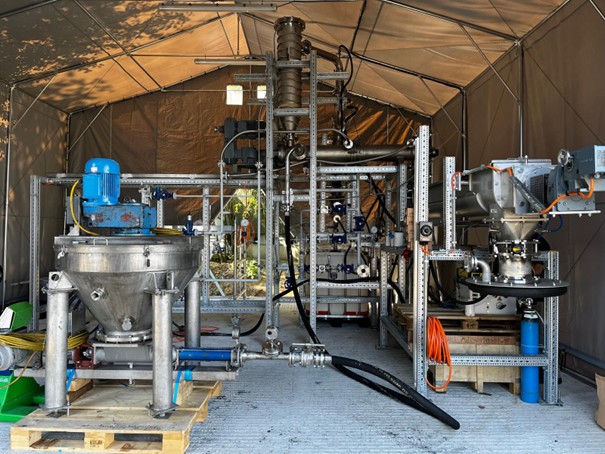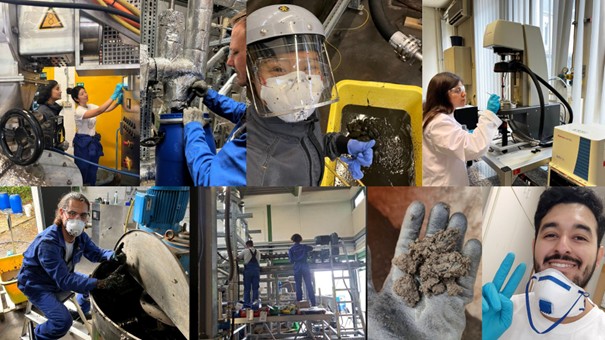“Running a pilot plant isn’t just science – it’s a rollercoaster. It takes months of planning, countless experiments, and endless hours of data assessment. But in the end, every challenge faced, every milestone reached, every laugh (and even the tears) becomes part of a journey you’re proud to have lived.” – Ayumi Schober (University of Stuttgart)
The Dryer-Grinder pilot plant marked the first operational milestone in the FlashPhos project – an innovative process aimed at recovering white phosphorus, a critical raw material, from sewage sludge. Designed and built by our partner SMS and operated by the University of Stuttgart’s Institute for Sanitary Engineering, Water Quality and Solid Waste Management (ISWA), the pilot was, on paper, a straightforward concept: scale down a thin-film dryer, redesign the internal setup to produce fine, dust-like sludge, and replicate the promising results from our pre-experiments.
What could possibly go wrong? Well, as anyone working in sludge treatment knows, real-world sewage sludge never plays by the book.
Finding a Home for the Pilot Plant
Our first challenge? Finding a wastewater treatment plant (WWTP) large enough to offer stable sludge quality for our scientific analysis, meaning one less factor to complicate the results. Luckily, the team at the Straubing WWTP in Germany welcomed us with open arms. A big thanks to Cristina Pop, Christian Großhauser, and the entire SER team (Eigenbetrieb Straubinger Stadtentwässerung und Straßenreinigung) for helping us set up the plant at a facility treating over 200,000 population equivalents.

Picture: Dryer-Grinder pilot plant installed in Straubing, Germany.
With installation and commissioning complete, we paused for the winter holidays, but returned due to a disaster. Heavy snowfall had collapsed the protective tent over the pilot plant. We had to rebuild everything from scratch.
That’s when we made the decision to relocate the pilot plant to the University of Stuttgart, where a WWTP for teaching and research could support continued testing.
Second Setup, New Surprises
The second installation went quicker, as experience is a great teacher. Commissioning was also smoother since our team already knew the ropes. But the moment we restarted operations, something hit us: the sludge smelled completely different. That was our first real reminder of just how diverse sludge can be, depending on its origin.
We kicked off testing by varying operational parameters to assess their influence on final particle size. When we increased the rotor speed, we observed a drop in particle size, likely due to enhanced mechanical shear. Promising! We even introduced new internal configurations to improve performance. One setup managed to reduce particle size to around 1 mm. Good, but still short of our target of 0.3 mm, the perfect size for optimal Flash Reactor performance.
The Sticky Truth About Drying Sludge
Our next challenge? Stickiness. As sludge dries, it passes through a “sticky phase” that causes agglomeration: big, stubborn clumps that ruin grinding efficiency.
We dove into the literature, borrowing insights even from non-sludge fields. We realized we needed a workaround. So, we started conditioning the sludge with Ca-rich additives, using materials that would later serve the Flash Reactor anyway.
This helped. Particle size dropped further, but still not to our ideal 0.3 mm threshold.
Broadening the Scope: New Sludges, New Insights
To test whether sludge composition was the key factor, we ran trials using samples from other WWTPs. This part of the journey was truly rewarding! Collaborative, generous professionals across different plants gave us access, ideas, and encouragement. It was also very exhausting. Each test meant full pilot plant system cleaning to avoid cross-contamination.
In the end, the results were clear: sludge composition plays a pivotal role in the Dryer-Grinder’s performance.
The End of a Chapter – Not the Book
After a full year of operation, we dismantled the pilot plant. It was bittersweet. The fieldwork is over, but the discoveries continue. Our data will help define the conditions needed to produce sludge powder suitable for efficient phosphorus recovery.
And that’s just the beginning! We are looking forward to our tests with the Flash Reactor.
Many thanks to all students and everyone else involved in the pilot plant operation!
Stay tuned for more insights as we continue our mission to make sludge a resource and phosphorus recovery more sustainable.

